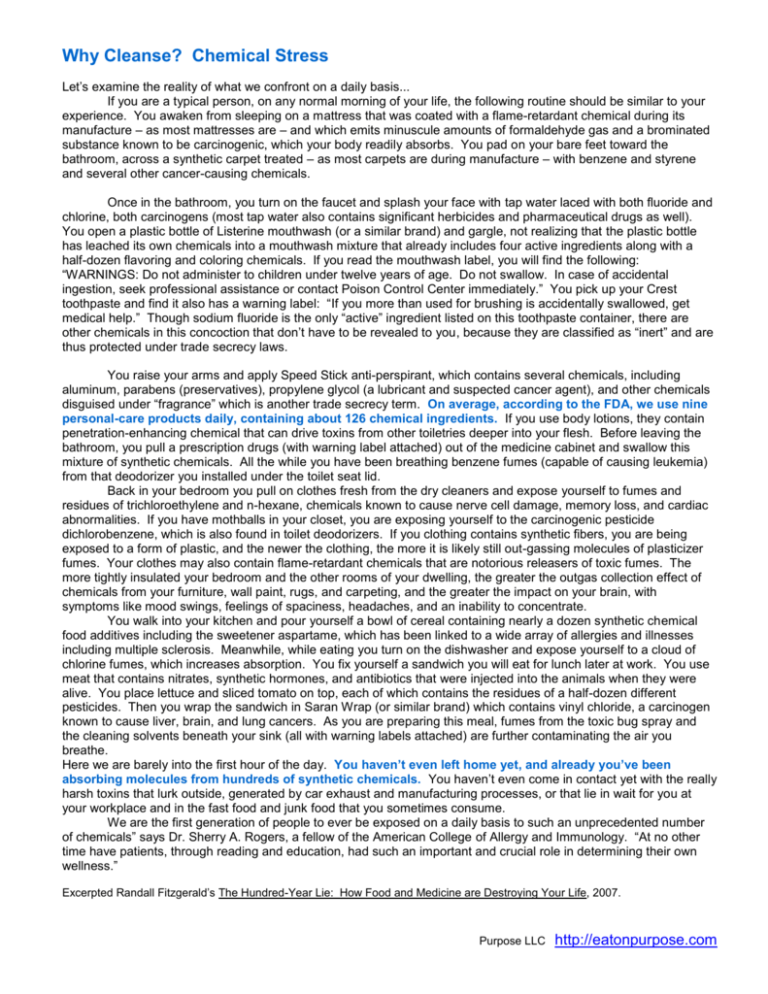You may be interested in this example of what we
advertisement

Why Cleanse? Chemical Stress Let’s examine the reality of what we confront on a daily basis... If you are a typical person, on any normal morning of your life, the following routine should be similar to your experience. You awaken from sleeping on a mattress that was coated with a flame-retardant chemical during its manufacture – as most mattresses are – and which emits minuscule amounts of formaldehyde gas and a brominated substance known to be carcinogenic, which your body readily absorbs. You pad on your bare feet toward the bathroom, across a synthetic carpet treated – as most carpets are during manufacture – with benzene and styrene and several other cancer-causing chemicals. Once in the bathroom, you turn on the faucet and splash your face with tap water laced with both fluoride and chlorine, both carcinogens (most tap water also contains significant herbicides and pharmaceutical drugs as well). You open a plastic bottle of Listerine mouthwash (or a similar brand) and gargle, not realizing that the plastic bottle has leached its own chemicals into a mouthwash mixture that already includes four active ingredients along with a half-dozen flavoring and coloring chemicals. If you read the mouthwash label, you will find the following: “WARNINGS: Do not administer to children under twelve years of age. Do not swallow. In case of accidental ingestion, seek professional assistance or contact Poison Control Center immediately.” You pick up your Crest toothpaste and find it also has a warning label: “If you more than used for brushing is accidentally swallowed, get medical help.” Though sodium fluoride is the only “active” ingredient listed on this toothpaste container, there are other chemicals in this concoction that don’t have to be revealed to you, because they are classified as “inert” and are thus protected under trade secrecy laws. You raise your arms and apply Speed Stick anti-perspirant, which contains several chemicals, including aluminum, parabens (preservatives), propylene glycol (a lubricant and suspected cancer agent), and other chemicals disguised under “fragrance” which is another trade secrecy term. On average, according to the FDA, we use nine personal-care products daily, containing about 126 chemical ingredients. If you use body lotions, they contain penetration-enhancing chemical that can drive toxins from other toiletries deeper into your flesh. Before leaving the bathroom, you pull a prescription drugs (with warning label attached) out of the medicine cabinet and swallow this mixture of synthetic chemicals. All the while you have been breathing benzene fumes (capable of causing leukemia) from that deodorizer you installed under the toilet seat lid. Back in your bedroom you pull on clothes fresh from the dry cleaners and expose yourself to fumes and residues of trichloroethylene and n-hexane, chemicals known to cause nerve cell damage, memory loss, and cardiac abnormalities. If you have mothballs in your closet, you are exposing yourself to the carcinogenic pesticide dichlorobenzene, which is also found in toilet deodorizers. If you clothing contains synthetic fibers, you are being exposed to a form of plastic, and the newer the clothing, the more it is likely still out-gassing molecules of plasticizer fumes. Your clothes may also contain flame-retardant chemicals that are notorious releasers of toxic fumes. The more tightly insulated your bedroom and the other rooms of your dwelling, the greater the outgas collection effect of chemicals from your furniture, wall paint, rugs, and carpeting, and the greater the impact on your brain, with symptoms like mood swings, feelings of spaciness, headaches, and an inability to concentrate. You walk into your kitchen and pour yourself a bowl of cereal containing nearly a dozen synthetic chemical food additives including the sweetener aspartame, which has been linked to a wide array of allergies and illnesses including multiple sclerosis. Meanwhile, while eating you turn on the dishwasher and expose yourself to a cloud of chlorine fumes, which increases absorption. You fix yourself a sandwich you will eat for lunch later at work. You use meat that contains nitrates, synthetic hormones, and antibiotics that were injected into the animals when they were alive. You place lettuce and sliced tomato on top, each of which contains the residues of a half-dozen different pesticides. Then you wrap the sandwich in Saran Wrap (or similar brand) which contains vinyl chloride, a carcinogen known to cause liver, brain, and lung cancers. As you are preparing this meal, fumes from the toxic bug spray and the cleaning solvents beneath your sink (all with warning labels attached) are further contaminating the air you breathe. Here we are barely into the first hour of the day. You haven’t even left home yet, and already you’ve been absorbing molecules from hundreds of synthetic chemicals. You haven’t even come in contact yet with the really harsh toxins that lurk outside, generated by car exhaust and manufacturing processes, or that lie in wait for you at your workplace and in the fast food and junk food that you sometimes consume. We are the first generation of people to ever be exposed on a daily basis to such an unprecedented number of chemicals” says Dr. Sherry A. Rogers, a fellow of the American College of Allergy and Immunology. “At no other time have patients, through reading and education, had such an important and crucial role in determining their own wellness.” Excerpted Randall Fitzgerald’s The Hundred-Year Lie: How Food and Medicine are Destroying Your Life, 2007. Purpose LLC http://eatonpurpose.com








